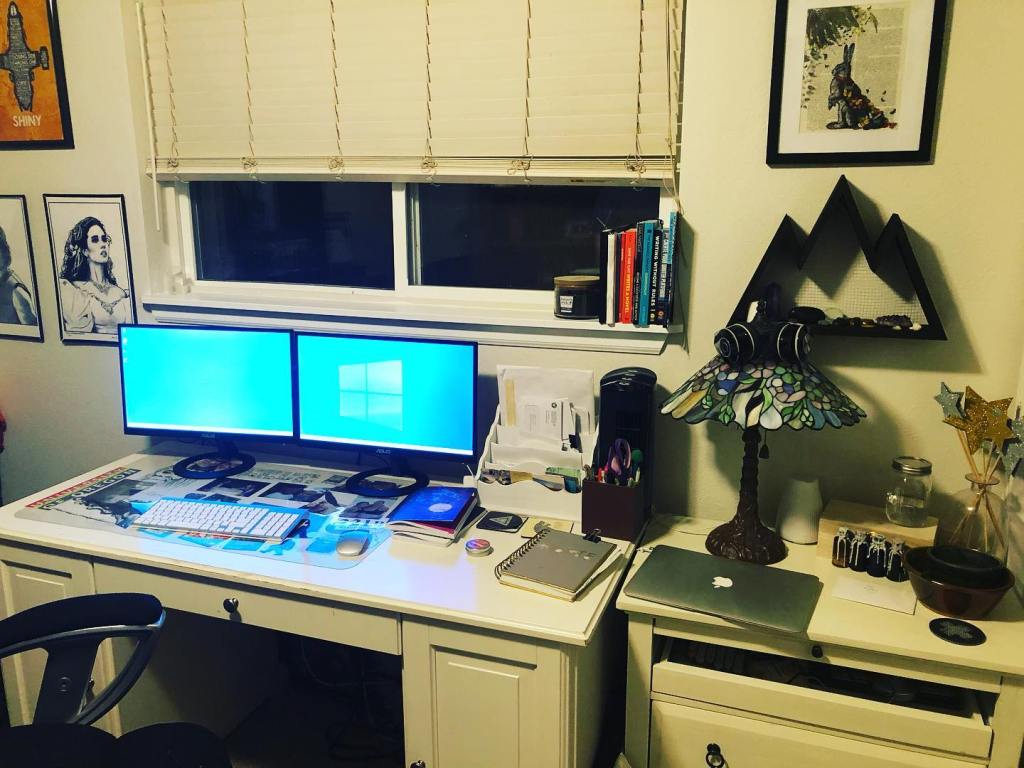
When I first started writing again as an adult, I often wrote at my kitchen table. But soon I moved to writing all over the place. I am ashamed to admit I used to be a smoker, so I often wrote outside on my balcony, or even in my car. But since being a bit more stable, and finally having a decent office and place to write, I’ve moved to writing at my desk. A month or so ago, my husband gave me his hand-me-down PC and got me dual screens. I am in love with the setup.
What exactly is this behind the scenes look at my writing? Well, frankly, nothing super exciting. But in case you are interested in my routine and how I do what I do, here it is.
My writing routine has changed drastically over the years, especially as I’ve quit smoking and changed jobs. I used to be a social worker, a case worker, and a drug and alcohol counselor. It was the most emotionally draining job I’ve ever had. So for a few years there, I barely wrote. I was usually able to eek out a few thousand words during Nanowrimo, or when I was feeling particularly good. But for the most part, all of my creative energy was sapped taking care of everyone else.
I burned out and that job ended just about 16 months ago. And frankly, it was the best thing to ever happen to me, my creativity, and my mental health. I finally had the energy to be creative. That was the catalyst that propelled me into publishing.
Here is my current routine: Wake up, go to work. I work in an office, and during the down time I am able to get some authoring done. I often write blog posts (like now), add things to my website, update Patreon, write my newsletter, create social media posts and graphics, do my finances, perhaps write on side projects, and do all the little things I need to do (formatting, creating universal links, etc) in order for my business to run. Once I get home, I usually take a few hours to relax, exercise, eat a meal, watch TV/read. My husband works early in the morning so when he goes to bed, I shower, get a cup of tea, and sit at my desk to write. I enjoy writing when the rest of the house is quiet and sleeping. It’s peaceful and I can let my mind wander without and distractions. This is when I get most of my writing in, from about 9pm until 11pm.
I write in sprints of 15-20mins at a time with 5 min breaks. And I use 4thewords to help keep me on track and focused. Sometimes I use focus apps. And sometimes I use a spread sheet, or StoryOrigin, or Nanowrimo to help me track my word count or projects.
I write about 2,000 words an hour if I get into a creative flow. And honestly, creative flow is my favorite thing. It’s hard to describe but it’s almost as though I’m just a conduit and the words just flow through me from someplace else. Sometimes I go into writing a scene with an idea in mind, and when I come out the other side, I realize the scene looks nothing like what I’d planned.
That’s also how I often surprise myself while writing. Things happen that I don’t expect, my characters act in ways I didn’t plan. Oh, the beauties of writing.
One of my other favorite things is when characters introduce themselves to me. It’s as though they step forward and wave, tell me their name, and sometimes tell me their stories. Sometimes I have to discover their stories as I write. That is why some characters seem better formed than others, and I pride myself on very character driven stories. I love discovering new characters, and I always kick myself when I don’t have a chance to take notes! I’ve lost a few that way. It sounds strange, but it’s the way my brain works. Some writers have conversations with their characters, I am more a passive observer as they live their lives and I observe and take notes.
Well, that’s just a snippet of my writing life. I get more ideas for stories than I could ever write over a lifetime, but I promise I will never stop telling stories as it is my passion and my life.






